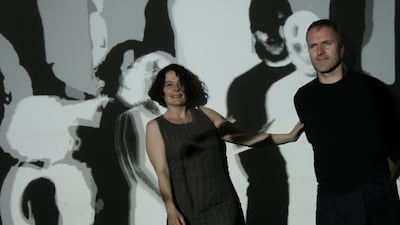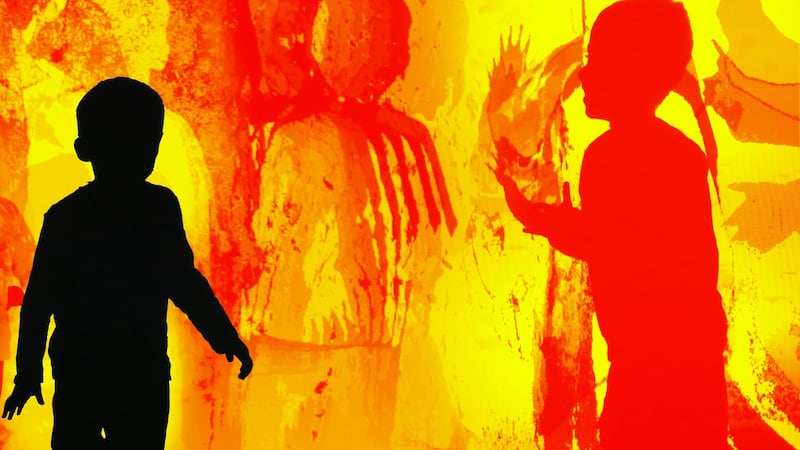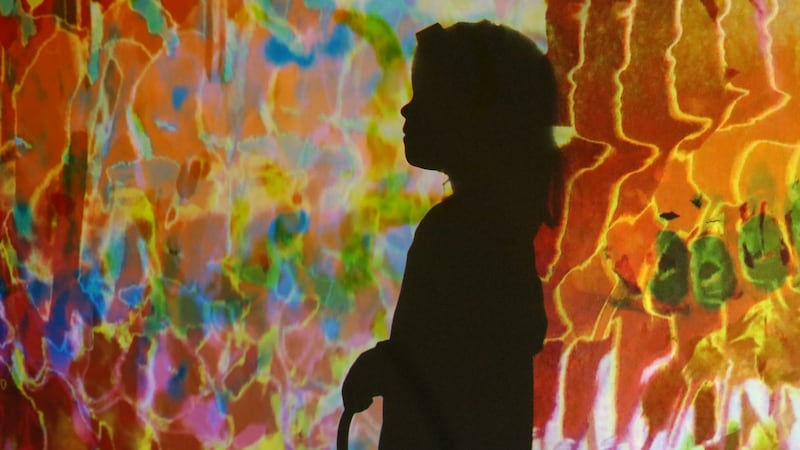Imagine you’re in a room: it’s almost like a hall of mirrors, except you are surrounded by digital screens. Images of your body echo across the space, as your movements are projected back, lingering on the screens; now in black and white, then making a rainbow. Initially experimenting with a few small movements, soon you start to describe more extravagant gestures. Maybe you’ll dance, your body painting the space as you go.

You begin to get a different sense of your presence. For the 40 students of the Marino Community Special School in Bray, the artwork, In the Picture, is also a project that explores how movement, light, and colour can be used to enhance concentration, and alter our sense of self. In the Picture was developed with the school by Paris-based Irish artists Anne Cleary and Denis Connolly, who have set up The School of Looking. Their aim is to bring art, science and technology together to explore questions of perception: how what and how we see influences our sense of being, and well-being in the world.
At the Marino school, the students range in age from pre-school to 18, and while they may have a range of issues, the majority are on the autism spectrum. Principal Oonagh Kenny describes the experience of In the Picture, which was selected through the Per Cent for Art scheme: "Concentration is an issue. A lot of our students would typically have a short attention span," she says. "Some, who were reluctant to engage initially, would lie on a mat and observe. Slowly you'd see them engaging – and it was lovely to see that."
“People with autism can use technology as a secondary route to communicate,” says Anne Cleary, who initially trained as an architect. “If they’re having difficulties in communication, they can build on the technology, and these experiences, to make a pathway to communication. People with autism are also often very, very creative in a way that’s not necessarily mainstream, so they can lean on the technology and the aesthetics they build, it’s a way in.”
In the Picture works on many levels, encouraging children who were reluctant to look at their own image to begin with hand gestures, then progress to a fuller engagement. The yoga and dance element of the project, led by Deirdre Murphy, had a relaxing effect, while also promoting movement. "They [the students] expressed choice," says Kenny. "They followed Deirdre's direction, and when they saw the impact on the screen, that made them explore in more depth different actions, different movements."
Problems with measuring
A problem comes with measuring. On the art side, it is enough to observe audiences and participants, and make qualitative assessments, but when you step over into the scientific side, or want to make health claims, quantitative research comes into play. Those who work in the arts don’t use the same metrics, or measure outcomes in the same way, as those in the sciences. This is an issue which also affects the relative esteem in which arts subjects are held by policymakers.
Maureen Quinn, principal at St Dympna's, a school for primary and post-primary children with special needs in Ballina, Co Mayo, hosted Face to Face, a version of the project that was delivered on a tablet computer, via a specially developed app. "The children were very positive about it," she says. "They won't involve themselves in something they don't like." She describes how the app improved attention span for two boys with autism spectrum disorder (ASD), enabling one to put what he was doing into words. "Any of these things to do with the visual arts curriculum are very hard to measure," she says. "And there's such an emphasis on maths and science that it sort of makes the other subjects seem less important. Music and arts don't seem to see the same recognition."

David Monaghan, who collaborated as lead researcher on the app project when he was at DCU (he is now with health research group Optum), expands on the issue: "We have to be so careful about stating medical benefits without studies and controls to back it up, and it's so difficult to gather that evidence." But he is also quick to stress that until those experiments can be designed, there is still huge value in working on projects that foster, as he puts it, "curiosity, intrigue, wonder and amazement.
“Kids might be told from an early age that they’re artistic, or scientific – and so these societal barriers are set up. Then, in a gallery, there’s this unwritten rhetoric of ‘don’t think, don’t touch, don’t be creative – we’ve already done that for you . . .’ So if we can design something like this for kids, whether they have ASD or they don’t, where you can say: everyone can be an artist, everyone can be a scientist, it just takes curiosity and a willingness to explore . . .”
Sense of agency
Alongside the delight and wonder, In the Picture, which has also been shown, in various guises, at Farmleigh, the South Tipperary Arts Centre, and at the Pompidou in Paris, enables visitors to feel a sense of agency in the world: you can literally see the effects of your actions. More philosophically, it also encourages the idea of legacy: actions leave a mark, have consequences. For those whose minds are at the stage of grappling with a sense of self, it facilitates a sense of presence in a non-threatening way.
A version of Face to Face was also tested at the Mullingar Educate Together National School, within a special needs class, back in 2013, and Cleary describes feedback from Orlaith Cunningham, one of the teachers, who said she found the app useful in enabling the children to focus on what they were looking at: "Viewing an object through the app could often help the child to notice more . . . children enjoyed looking at flowers or trees through the app during walks, and this was useful as it makes the child more aware of where he/she is." This idea of screens focusing attention for those with special needs is an interesting counterbalance to the more general view of screens as a scourge.
Used wisely, screens can deliver feedback that encourages us to view the world differently. They can also help us to focus on details, and entertain different perspectives. This can work to give developmental and educational benefits in a challenging world – or a world designed for people with different abilities and skills. It can also help everyone to gain insights into the lives of others.
Visual perception both informs our sense of self and is altered by our moods and emotions. Studies have shown that depression can dull our perception of colours, and of physical “reality”: for example, we may perceive an incline to be steeper when we are depressed. This leads to a fascinating set of questions concerning the nature of reality, as filtered through our own vision and linguistic tools.

Working as Connolly Cleary, and now through The School of Looking, Anne Cleary and Denis Connolly have explored various forms of perception. Their Metaperceptual Helmets were a fun series of headgear that gave you the vision experiences of different animals – from the horse, which has extraordinary peripheral vision, but a blind spot directly in front (which explains why horses will often appear to sidle up to you in a field), to the chameleon, which can swivel its eyes independently and see directly in front, and behind.
Colour channels
A more recent project, in collaboration with Patrick Cavanagh, then director of the Vision Lab at the Université Paris Descartes, and who is now at Harvard, was for David Byrne's Theatre of the Mind in 2016. Byrne, of Talking Heads fame, created a series of rooms on Governor's Island, New York, exploring neurological experiments. Denis Connolly describes how the six helmets created by the artists for the project filtered out different colours, leaving the viewer in a yellow or a blue world.
“You’ve essentially got three colour channels,” explains Connolly. “Black and white, red and green, and blue and yellow. Blue and yellow seems to be the most primitive; some animals seem to only have the blue and yellow receptors, and when we go back into that zone we seem to go into a more primitive part of the brain.” Or, to put it another way, it seems you lock out some functions of the way your brain works when you limit colours, so you’re channelling information to certain parts of the brain.
“Blue and yellow affects perception of motion,” says Connolly. “So you’re seeing what happens when you turn off certain switches in your brain, but in a harmless way. It was very profound, but it was also a bit of a thrill,” he adds.
There is some limited research on colour preferences in children with autism, though interestingly it is quite conflicting, probably due to the wide range of conditions within the autism spectrum description. However, using colour to explore how the brain works, and what happens in brains that may have been damaged, by stroke, for example, opens up hugely exciting possibilities. The question for art and science is how to enable the disciplines to collaborate, when the criteria for success in each is so different.
David Monaghan proposes a different way of thinking about things: “It’s the great thing about science, and about art,” he says. “You have this freedom to play with things, and where you end up is never where you started from.”
Artists experiment, driven by interest and fascination, but are woefully underfunded; meanwhile, in science, freedom needs to be protected. “We’ve gone too far down the industry link,” says Monaghan. “We’re not funding enough basic research. You have to give people a safe atmosphere to fail without losing their jobs. You learn way more from a fail than you do from a success.”
Cleary and Connolly are currently installing images from In the Picture at the Marino School in Bray, and are working on evaluation methods to take the project further.













